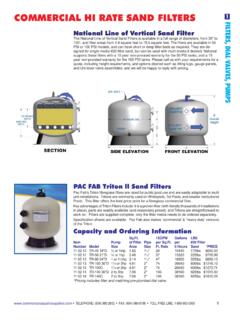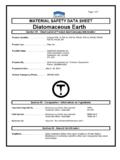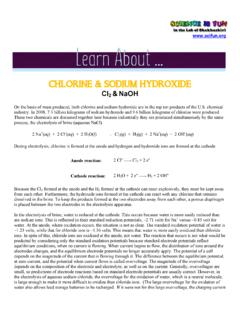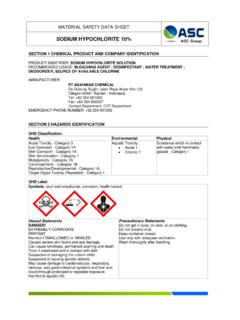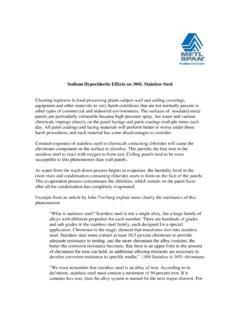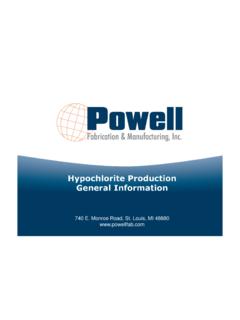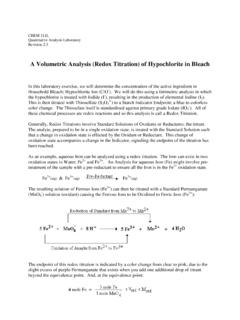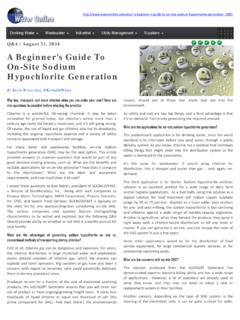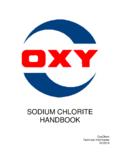Transcription of MATERIAL SAFETY DATA SHEET Sodium …
1 Page 1 of 7. MATERIAL SAFETY DATA SHEET . Sodium hypochlorite 3-20%. Section 01 - Product And Company Information Product Identifier .. Sodium hypochlorite (3-20%). Product Use .. Disinfectant, bleaching agent, source of available chlorine, deodorizer. Supplier Name .. ClearTech Industries Inc. 1500 Quebec Avenue Saskatoon, SK. Canada S7K 1V7. Prepared .. ClearTech Industries Inc. Technical Department Phone: (306)664-2522. Preparation .. September 5, 2015. 24-Hour Emergency Phone .. 306-664-2522. Section 02 - Composition / Information on Ingredients Hazardous .. Sodium hypochlorite CAS .. Sodium hypochlorite 7681-52-9. Synonym (s)..Industrial bleach, hypo, bleach, Javel water, household bleach, Hypochlor- 12. Section 03 - Hazard Identification Page 2 of 7.
2 Irritant of the nose and throat, causing coughing, difficulty breathing, and pulmonary edema. Skin Contact / Absorption .. Causes severe skin irritation with blistering and ulceration. Eye .. Causes severe irritation of the mucous membranes of the eyes. May cause severe eye damage.. Burning of the mouth and throat, abdominal cramps, nausea, vomiting, diarrhea, shock. May lead to convulsions, coma, and even death. Exposure Limits .. ACGIH/TLV-TWA: (chlorine). Section 04 - First Aid Measures .. Remove victim to fresh air. Give artificial respiration only if breathing has stopped. If breathing is difficult, give oxygen. Seek immediate medical attention. Skin Contact / Absorption .. Remove contaminated clothing. Wash affected area with soap and water.
3 Seek medical attention if irritation occurs or persists. Eye .. Flush immediately with water for at least 20 minutes. Forcibly hold eyelids apart to ensure complete irrigation of eye tissue. Seek immediate medical attention.. Do not induce vomiting. If vomiting occurs, lean victim forward to prevent breathing in vomitus. Give large amounts of water. Do not give anything by mouth to an unconscious or convulsing person. Seek immediate medical attention. Additional .. Not available Section 05 - Fire Fighting Measures Conditions of Flammability .. Non-flammable Means of .. Product does not burn. Use appropriate extinguishing media for MATERIAL that is supplying the fuel to the fire. Flash . Not applicable Auto-ignition Temperature . Not applicable Page 3 of 7.
4 Upper Flammable Limit .. Not applicable Lower Flammable .. Not applicable Hazardous Combustible Decomposition may produce chlorine gas and/or hydrogen chloride gas. Special Fire Fighting Wear NIOSH-approved self-contained breathing apparatus and protective clothing. Explosion Hazards .. Pressure buildup in containers could result in an explosion when heated or in contact with acidic fumes. Vigorous reaction with oxidizable organic materials may result in a fire. Section 06 - Accidental Release Measures Leak / .. Wear appropriate personal protective equipment. Ventilate area. Stop or reduce leak if safe to do so. Restrict access to spill area until clean up is complete. Prevent MATERIAL from entering sewers, waterways or confined spaces. Soak up smaller spills with absorbent MATERIAL that does not react with spilled MATERIAL .
5 Flush with water to remove any residue. Deactivating .. Spills can be carefully neutralized first with Sodium sulphite, Sodium metabisulphite or other dechlorination agent for no chlorine residual, then a pH adjustment may be required with hydrochloric acid until the pH is 7. Note neutralization reactions may produce heat so necessary precautions must be taken. Local regulatory agencies should also be contacted for proper disposal. Section 07 - Handling and Storage Handling .. Use proper equipment for lifting and transporting all containers. Use sensible industrial hygiene and housekeeping practices. Wash thoroughly after handling. Avoid all situations that could lead to harmful exposure. Storage .. Store in a cool, dry, well-ventilated place.
6 Keep container tightly closed, and away from incompatible materials. Venting of containers is advisable. Section 08 - Personal Protection and Exposure Controls Protective Equipment Eyes.. Chemical goggles, full-face shield, or a full-face respirator is to be worn at all times when product is handled. Contact lenses should not be worn;. they may contribute to severe eye injury. Page 4 of 7. Respiratory .. A NIOSH-approved respirator suitable for chlorine is recommended. Where a higher level of protection is required, use a self-contained breathing apparatus. Gloves .. Impervious gloves of chemically resistant MATERIAL (rubber or PVC) should be worn at all times. Wash contaminated clothing and dry thoroughly before reuse. Clothing .. Body suits, aprons, and/or coveralls of chemical resistant MATERIAL should be worn at all times.
7 Wash contaminated clothing and dry thoroughly before reuse. Footwear .. Impervious boots of chemically resistant MATERIAL should be worn at all times. Engineering Controls Ventilation Requirements .. Mechanical ventilation (dilution or local exhaust), process or personnel enclosure and control of process conditions should be provided. Supply sufficient replacement air to make up for air removed by exhaust systems. Other .. Emergency shower and eyewash should be in close proximity. Section 09 - Physical and Chemical Properties Physical .. Liquid Odor and Appearance .. Strong chlorine odour. Clear, greenish-yellow solution. Odor .. Not available Specific Gravity (Water=1) .. at 20 C (12% trade). Vapor Pressure (mm Hg, 20C) .. Hg at 20 C ( wt %).
8 Vapor Density (Air=1).. Not available Evaporation .. Not available Boiling .. Slowly decomposes above 40oC. Freeze/Melting .. ~ -15 C (12% trade).. < 12. Water/Oil Distribution Not available Page 5 of 7. Bulk .. Not available % Volatiles by Volume .. Not available Solubility in .. Complete Molecular .. NaOCl Molecular .. Section 10 - Stability and Reactivity .. Unstable at temperatures above 40 C, in sunlight, a nd in contact with acid.. Incompatible with strong acids, ammonia, oxidizable materials, nickel, copper, tin, manganese, and iron. Hazardous Products of Chlorine (by reaction with acids), oxygen (by reaction with nickel, copper, tin, manganese, iron), Sodium chloride, Sodium chlorate, with increased temperature.. Will not occur Section 11 - Toxicological Information.
9 Strong irritant .. Not available Chronic/Acute Effects .. If over-exposed to the solution, there will be constant irritation of the eyes, nose, and throat. Synergistic .. Not available Animal Toxicity .. LD50(oral,rat): 8910mg/kg (undiluted Sodium hypochlorite ).. Not considered to be carcinogenic (IARC and ACGIH). Reproductive .. Not available .. Not available .. Not available Page 6 of 7. Section 12 - Ecological Information Fish .. Not available .. Not available Environmental Effects . Not available Section 13 - Disposal Consideration Waste .. Dispose in accordance with all federal, provincial, and/or local regulations including the Canadian Environmental Protection Act. Section 14 - Transport Information TDG Classification Class .. 8 (not regulated at solutions below 7%).
10 III (not regulated at solutions below 7%). PIN .. UN 1791(not regulated at solutions below 7%). Other .. Secure containers (full and/or empty) with suitable hold down devises during shipment. Section 15 - Regulatory Information WHMIS ..E. NOTE: THE PRODUCT LISTED ON THIS MSDS HAS BEEN CLASSIFIED IN ACCORDANCE WITH THE. HAZARD CRITERIA OF THE CANADIAN CONTROLLED PRODUCTS REGULATIONS. THIS MSDS. CONTAINS ALL INFORMATION REQUIRED BY THOSE REGULATIONS. NSF is certified under NSF/ANSI Standard 60 for disinfection and oxidation at a maximum dosage for the following: Sodium hypochlorite 5%: 174mg/L. Sodium hypochlorite 6%: 145mg/L. Sodium hypochlorite 7%: 125mg/L. Sodium hypochlorite 8%: 109mg/L. Sodium hypochlorite 9%: 97mg/L. Sodium hypochlorite 10%: 87mg/L.


